Ever since I read Paolo Coehlo’s The Pilgrimage, I have been fascinated by the Camino de Santiago de Compostella (The Way of St James) pilgrimage in Spain. This allure of a 500 mile walk through the Pyrenees and Spain has only grown since I watched The Way, with Martin Sheen and directed by Emilio Estevez (I highly recommend it). As I searched online for information on walking the pilgrimage, an accident of typing lead me to The Pilgrimage of New York. In its 3rd year,
This year the Pilgrimage of New York highlights the spirituality and history of the Society of Jesus (commonly known as the “Jesuits”), by adding to the pilgrimage route two churches administered by the Jesuits and named for Jesuit saints (the Church of St. Francis Xavier and the Church of St. Ignatius Loyola), and another that commemorates a Jesuit saint (St. Aloysius Gonzaga). The Jesuit religious order has profoundly contributed to the Church throughout the world and particularly here in New York City.
Intrigued and with a strong personal connection to the Jesuits, I signed up for a 13.5 mile walk through Manhattan…Like the pilgrims in Chaucer’s Cantebury Tales, I arrived early morning by myself and quickly found myself part of a diverse and vibrant community. I was eager to learn about the Jesuit saints and see some beautiful NY churches, the pilgrimage itself; however, was so much more. It is no surprise to anyone that the American Church is currently deeply divided, but in this very diverse group of pilgrims (256!) there was an unmistakable unity of faith and a deep sense that this was our history. The day was, for me, a very Ignatian encounter with my Church and my City.
We began at 8:30 am (although my day began on the LIRR at 6:15!) at the Shrine of St. Francis Xavier Cabrini at 190th St and Fort Washington Ave. (I am embarrassed to admit that I have been to the Cloisters at least 3 times and never walked across the street to notice the Shrine.) St. Francis Xavier Cabrini came to New York from her native Italy to serve and educate the Catholic immigrant population of New York. The Patron Saint of Immigrants, Mother Cabrini focused on education, a theme that would be revisited throughout the day (as all the Jesuit churches would also have schools affiliated with them- St. Al’s Grade School, Regis HS, and Xavier HS) and despite being petrified of the water, Mother Cabrini crossed the ocean 23 times in service of her mission. It seemed fitting to begin at the Shrine of the patron saint of immigrants; one cannot understand Catholic New York without understanding that we are a church of immigrants. This is poignantly demonstrated in this statue of St. Cabrini outside the shrine –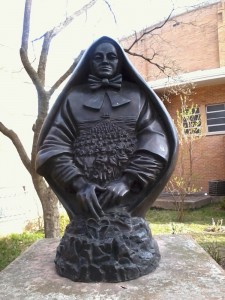
As we asked St. Francis Xavier Cabrini to “Be for us a companion on the walk, our guide at the crossroads” we set out down Fort Washington Avenue and Frederick Douglas Blvd to St. Aloysius Gonzaga Church (219 West 132 St) in Harlem. As I walked, getting to know my new friends (they were all participants in a Bible study at St. Patrick’s Cathedral and immediately welcomed me into their group), I was struck by the sights, sounds and hidden gems (like a Hamilton historic sight) scattered throughout this section of Harlem. The beautiful architecture, buildings restored and those in need of attention, how vibrant and busy the streets of Harlem are on a Saturday morning. (And how strange this scattered group of 250 must’ve looked en route to St. Al’s).
St Aloysius Gonzaga has a beautiful and imposing facade, yet is tucked away on a random street. Inside it is a welcoming and vibrant, as its pastor Fr. Cemu who introduced us to 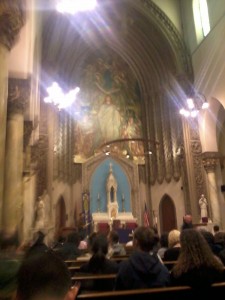 St. Alyosius Gonzaga, a man born into wealth and privilege. He gave up all rights to his inheritance and joined the Jesuits (rejection of wealth and privilege to serve was another theme of these Saints). One of the “Jesuit Boy Saints,” he is a fitting patron for the school attached to the parish (K-8). More than an encounter with this impressive Jesuit saint, I felt as if I had been welcomed into the community of St Al’s. In front of a beautiful African Madonna and Child painting, 4 members of the Gospel Choir inspiringly sang as we meditated and prayed – and a lifelong parishioner and graduate of the school spoke movingly about what St. Al’s meant for him, for the parish and the Harlem Community. A parish that has at times flourished and at times struggled (like the community it serves), I felt honored that both the pastor and parishioners welcomed us into a glimpse not of their building and the saint for whom its named but into their parish life. This is what it means to be part of the Catholic church – unity in diversity.
St. Alyosius Gonzaga, a man born into wealth and privilege. He gave up all rights to his inheritance and joined the Jesuits (rejection of wealth and privilege to serve was another theme of these Saints). One of the “Jesuit Boy Saints,” he is a fitting patron for the school attached to the parish (K-8). More than an encounter with this impressive Jesuit saint, I felt as if I had been welcomed into the community of St Al’s. In front of a beautiful African Madonna and Child painting, 4 members of the Gospel Choir inspiringly sang as we meditated and prayed – and a lifelong parishioner and graduate of the school spoke movingly about what St. Al’s meant for him, for the parish and the Harlem Community. A parish that has at times flourished and at times struggled (like the community it serves), I felt honored that both the pastor and parishioners welcomed us into a glimpse not of their building and the saint for whom its named but into their parish life. This is what it means to be part of the Catholic church – unity in diversity.
After St. Al’s we walked down towards St. Ignatius Loyola – the juxtaposition of Harlem and the Upper East Side is striking. In many ways, the journey to St. Ignatius and St. Patrick’s Cathedral was an odd “pause” between the bustling streets of Harlem and those of Chelsea. 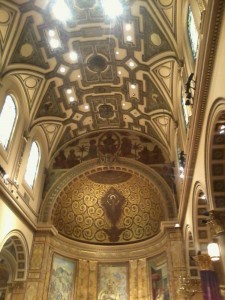 Every neighborhood in New York City has its own character and culture. St. Ignatius Loyola is a grand church full of artistic beauty and symbolism. Fr. Dugan, SJ gave us a brief history of Inigo and his companions and the symbolism around the church. The swirling hearts around Christ crucified, it is not as easy to see in the photo to the right – but this image of hearts swirling around the cross, as I sat there on pilgrimage during Lent, surrounded by fellow pilgrims from many countries all who call New York and the Catholic Church home. Ignatian spirituality centers around finding God in all things – and I found I was discovering both God and neighbor all around me in ways I had not previously noticed. As a moral theologian, I try and be attentive to my surroundings, in particular to poverty (which I noticed yesterday -in the boarded up brownstones on 145 St and the homeless on 14st) but it was this more inclusive reality of both the church and city I began to notice as I walked through these neighborhoods. As I type, I find myself at a loss for words to describe this palpable sense of unity, diversity, brokenness and grace I felt. And as I began to feel the weariness in my legs (13.5 miles is A LOT!), I thought of my neighbors who feels this weariness on a daily basis – those who have to walk miles to work, roam the city searching for shelter, or those on a sometimes deadly journey to reach America (and often New York). The theme of migration came up a lot in conversation – as I chatted with a new sociologist friend (who’s area is migration) but it was also present in the many countries represented within the “Bible Study” group.
Every neighborhood in New York City has its own character and culture. St. Ignatius Loyola is a grand church full of artistic beauty and symbolism. Fr. Dugan, SJ gave us a brief history of Inigo and his companions and the symbolism around the church. The swirling hearts around Christ crucified, it is not as easy to see in the photo to the right – but this image of hearts swirling around the cross, as I sat there on pilgrimage during Lent, surrounded by fellow pilgrims from many countries all who call New York and the Catholic Church home. Ignatian spirituality centers around finding God in all things – and I found I was discovering both God and neighbor all around me in ways I had not previously noticed. As a moral theologian, I try and be attentive to my surroundings, in particular to poverty (which I noticed yesterday -in the boarded up brownstones on 145 St and the homeless on 14st) but it was this more inclusive reality of both the church and city I began to notice as I walked through these neighborhoods. As I type, I find myself at a loss for words to describe this palpable sense of unity, diversity, brokenness and grace I felt. And as I began to feel the weariness in my legs (13.5 miles is A LOT!), I thought of my neighbors who feels this weariness on a daily basis – those who have to walk miles to work, roam the city searching for shelter, or those on a sometimes deadly journey to reach America (and often New York). The theme of migration came up a lot in conversation – as I chatted with a new sociologist friend (who’s area is migration) but it was also present in the many countries represented within the “Bible Study” group.
Many pilgrims stopped at St Patrick’s Cathedral to visit the Crypt…the rest of us took a slightly longer lunch then scrambled to make it down to ST. Francis Xavier on 15th St on time! At Xavier we were greeted by Fr. Constantino, SJ who walked us through the wonders of this glorious Roman style church – pointing out (with a laser pointer that made every teacher in the pews smile!) the inculturation of American Catholicism…the traditional imagery combined with American imagery (lilies in particular). Xavier recently underwent a massive restoration and the results are incredible – as the beauty of the artwork is once again visible. 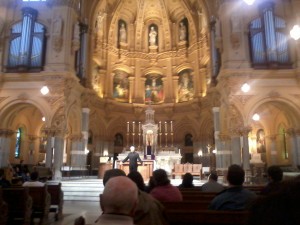 Fr. Constantino made theological connections with ease and clarity reminding all of us of the immanence of God with us during Lent and this pilgrimage. There is so much to love about this church, but one particular aspect of the renovation struck me as really bringing together the past, present, and future quite poignantly – the new altar. Part of the renovations involved replacing the old hard oak kneelers with new, cushioned kneelers. But what is one to do with a stack of oak that had been used for over a 100years of prayer? At St Francis Xavier,you take them and fashion them into a new altar.
Fr. Constantino made theological connections with ease and clarity reminding all of us of the immanence of God with us during Lent and this pilgrimage. There is so much to love about this church, but one particular aspect of the renovation struck me as really bringing together the past, present, and future quite poignantly – the new altar. Part of the renovations involved replacing the old hard oak kneelers with new, cushioned kneelers. But what is one to do with a stack of oak that had been used for over a 100years of prayer? At St Francis Xavier,you take them and fashion them into a new altar. 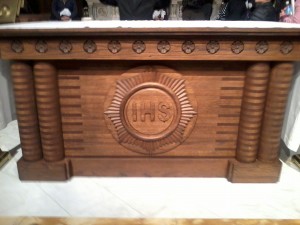 I am still struck by the beauty of the altar and the fittingness of it.
I am still struck by the beauty of the altar and the fittingness of it.
From Xavier we needed to travel as a group down to the 9/11 memorial. Since we had a group admission, for the first time we needed to really stick together as a group heading downtown (a bit complicated with 250!). We gathered on the steps of St. Peter’s Church (the oldest parish in NYC) and walked over to the 9/11 memorial. It is difficult for me to put into words the complex emotions of visiting the 9/11 memorial. Walking around the flowing waters, I was struck once again by the diversity of names, nationalities, etc. Just like my church and my city, no one has a monopoly on the tragedy of 9/11.While at the beginning of the day I had trouble figuring out how visiting the 9/11 memorial “fit” in to the day, by the time we arrived it seemed the most natural next stop. 9/11 is, I guess, for my generation a moment like Pearl Harbor was for my grandparents – a tragedy after which everything seems different – but one full of complicated and mixed emotions about that new reality. (I found myself praying not only for those lost on that day and their families, in solidarity with victims of terrorism around the world; but also lamenting the victims of the Iraq and Afghanistan wars as my grandparents did the victims of Hiroshima and Nagasaki).
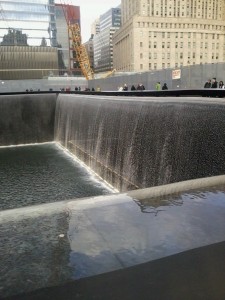 Finally, we ended with a Pilgrims Mass at the Shrine of St. Elizabeth Ann Seton celebrated by Fr. James Van Dyke, SJ. He remarked that there was 1 Jesuit saint we had left out – St. Isaac Jogues who had traveled basically the same 13.5 mile path we traveled – we had essentially been walking in his footsteps. Linking our pilgrimage to the gospel story of Jesus raising Lazarus – Fr. VanDyke pointed out that throughout the Gospels Jesus says to his disciples “Come and See” but in this story – his friends say to him “come and see.” Jesus does, entering into the tragedy and pain, the awful, smelly, messy situation of death (unclean)to be with that family. Pilgrimage itself is an invitation to come and see – to walk with Jesus and “see the needs of the Lord’s people with the Lord’s eyes” as is the method of the Spiritual exercises.
Finally, we ended with a Pilgrims Mass at the Shrine of St. Elizabeth Ann Seton celebrated by Fr. James Van Dyke, SJ. He remarked that there was 1 Jesuit saint we had left out – St. Isaac Jogues who had traveled basically the same 13.5 mile path we traveled – we had essentially been walking in his footsteps. Linking our pilgrimage to the gospel story of Jesus raising Lazarus – Fr. VanDyke pointed out that throughout the Gospels Jesus says to his disciples “Come and See” but in this story – his friends say to him “come and see.” Jesus does, entering into the tragedy and pain, the awful, smelly, messy situation of death (unclean)to be with that family. Pilgrimage itself is an invitation to come and see – to walk with Jesus and “see the needs of the Lord’s people with the Lord’s eyes” as is the method of the Spiritual exercises.
We all tend to think of pilgrimages as if they are big journeys – to Spain, Rome, Jerusalem, or even Canterbury. But St. Ignatius saw his life as a pilgrimage – as Fr. Van Dyke reminded us, challenging us to see the grace of this pilgrimage as an invitation to be more conscious of this. A grace of this pilgrimage for me was definitely to focus my attention on the reality that we are a pilgrim church, a church of immigrants trying to answer Jesus’ call to “Come and See.” The 3rd year of the Pilgrimage of New York was a resounding success and a wonderful reminder to go on pilgrimage and “see” both the church and the community around us – seeking in the Jesuit tradition – to find God in all things.


Beautiful, Meghan! Thanks so much for sharing your pilgrimage and the Jesuit spirituality that shines through it.
You have a gift. The detailed description that you provide about the Pilgrimage is impressive. I am also a fan of Pablo Coehlo’s book and have read “The Pilgrimage” This is my 3rd time joining this event by myself. From Staten Island, in the morning, I had a two hour commute to Mother Cabrini Shrine. After I came home last night, I felt and indescribable joy and peace. For me as a Catholic, walking the streets of NY provides not only an opportunity to pray, medidate and praise God for all the beauty that there is to see in this vibrant City but for the diversity that populates it. In every corner, in every street and neighborhood (to include hospitals) that we passed there was a vendor, a mother, children and joggers running in the streets, homeless. As we walked along, I felt like we were covering the city, touching each life with the Grace of God. As a native new yorker, it also an opportunity to learn about the City and my Faith so we can showcase to the world. So many amazing Catholic Churches and history that otherwise I would have never discovered as well as good friends that I have met over the past three years. New York may be known for many negative things. But amazing things are happening here every day. Two hundred fifty people of different ages and cultures united in one faith and for one purpose. I concur that the Pilgrimage was a total success. It was in God’s plan and He made it happen through the help of some gifted individuals.
Thank you so much for this beautifully written essay about your pilgrimage. Gosh, I read The Pilgrimage so many years ago and it made such a deeply profound influence up on me; one day I hope to go. In any case, thank you again, I almost passed this by in the interest of time, but I am once again reminded to pay attention to things I might otherwise pass by… Such is the way of the pilgrim.